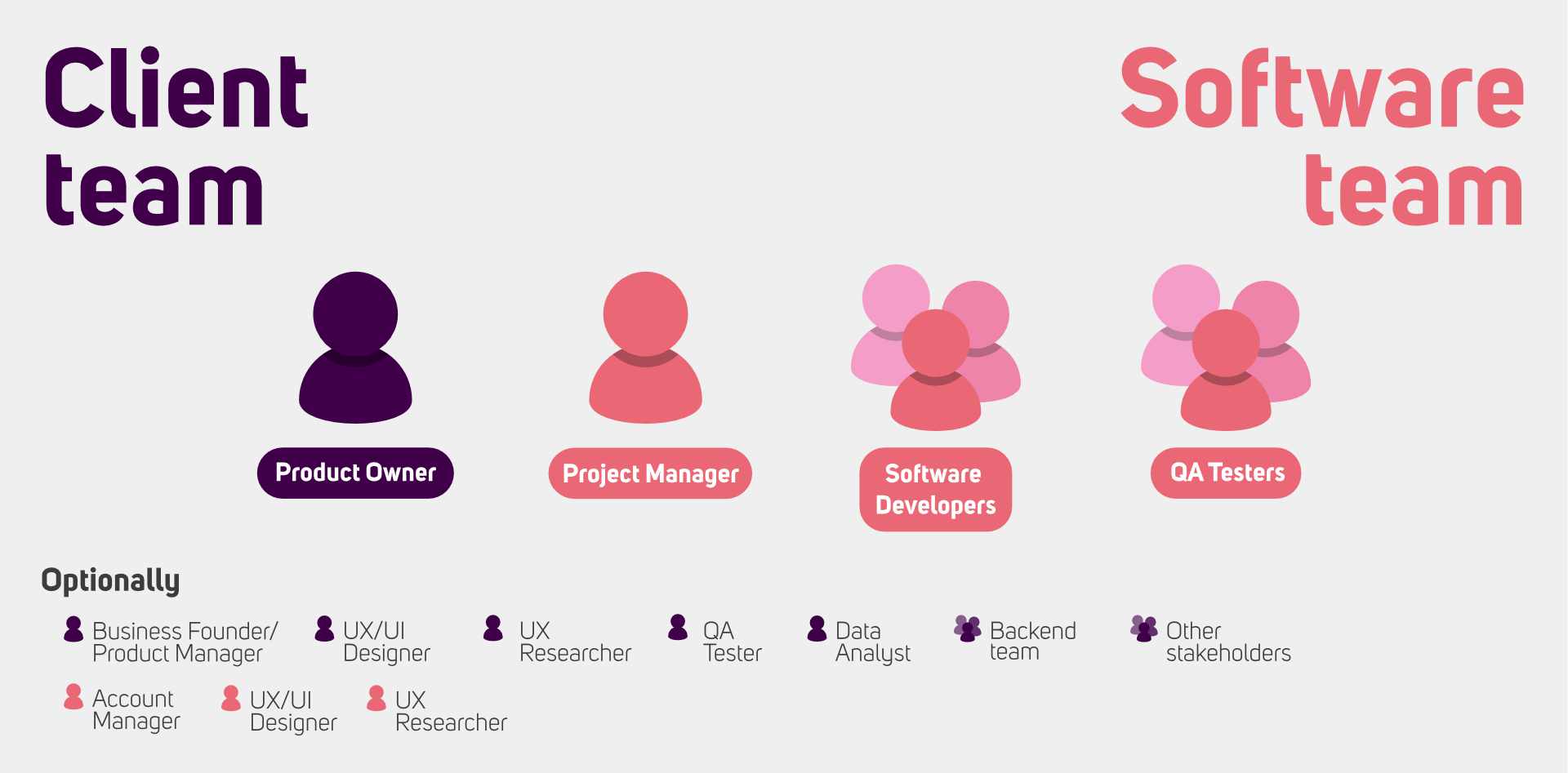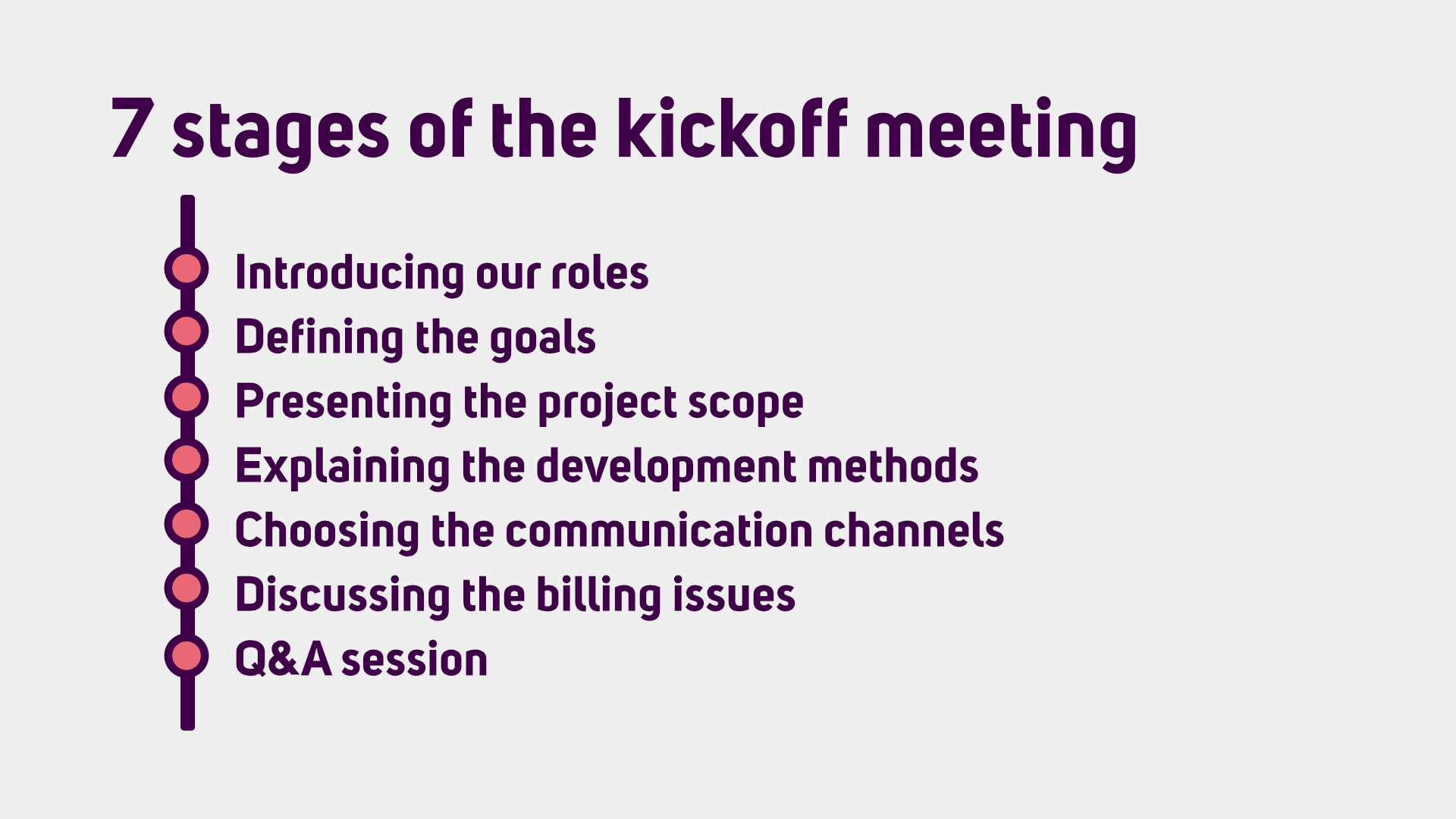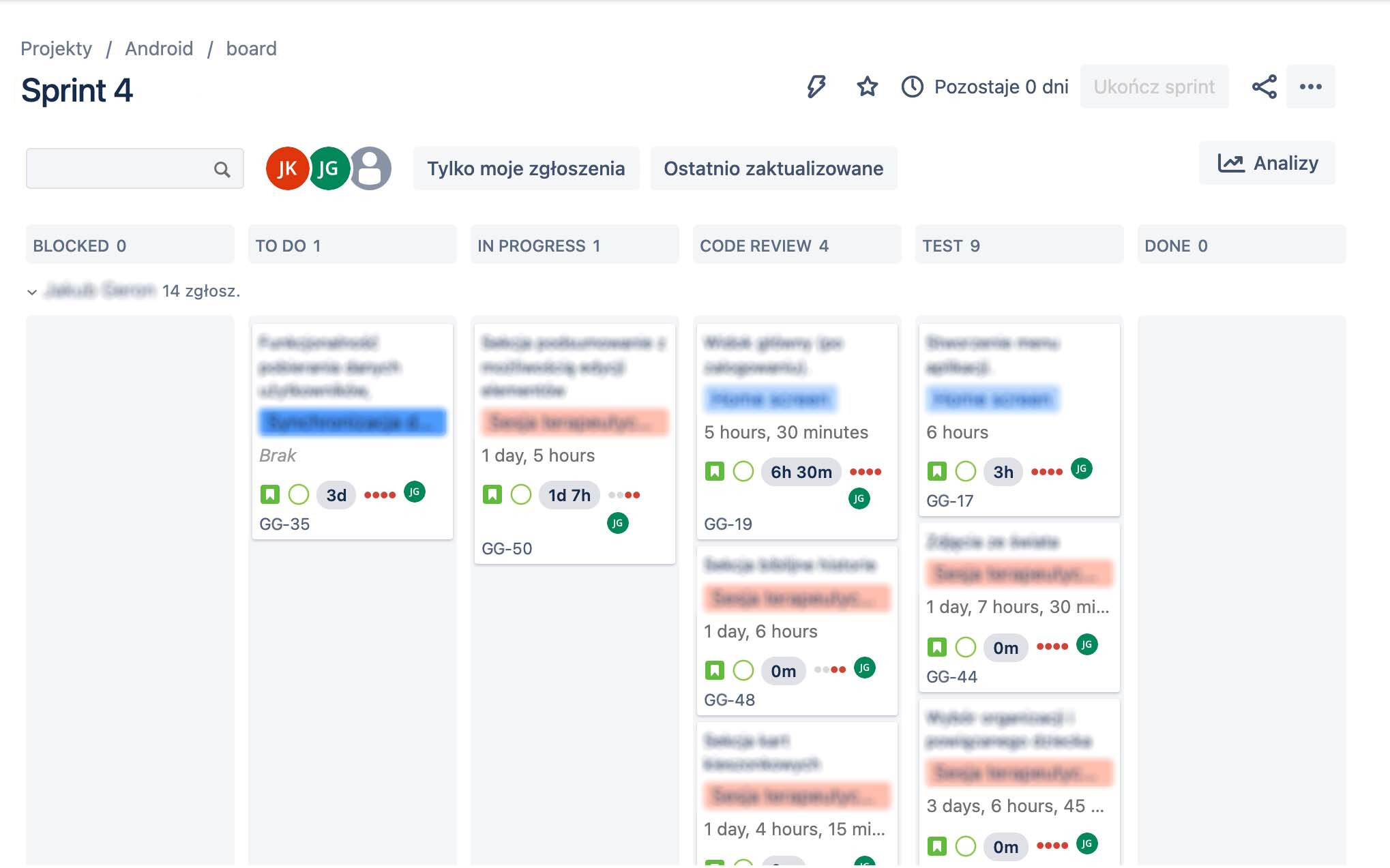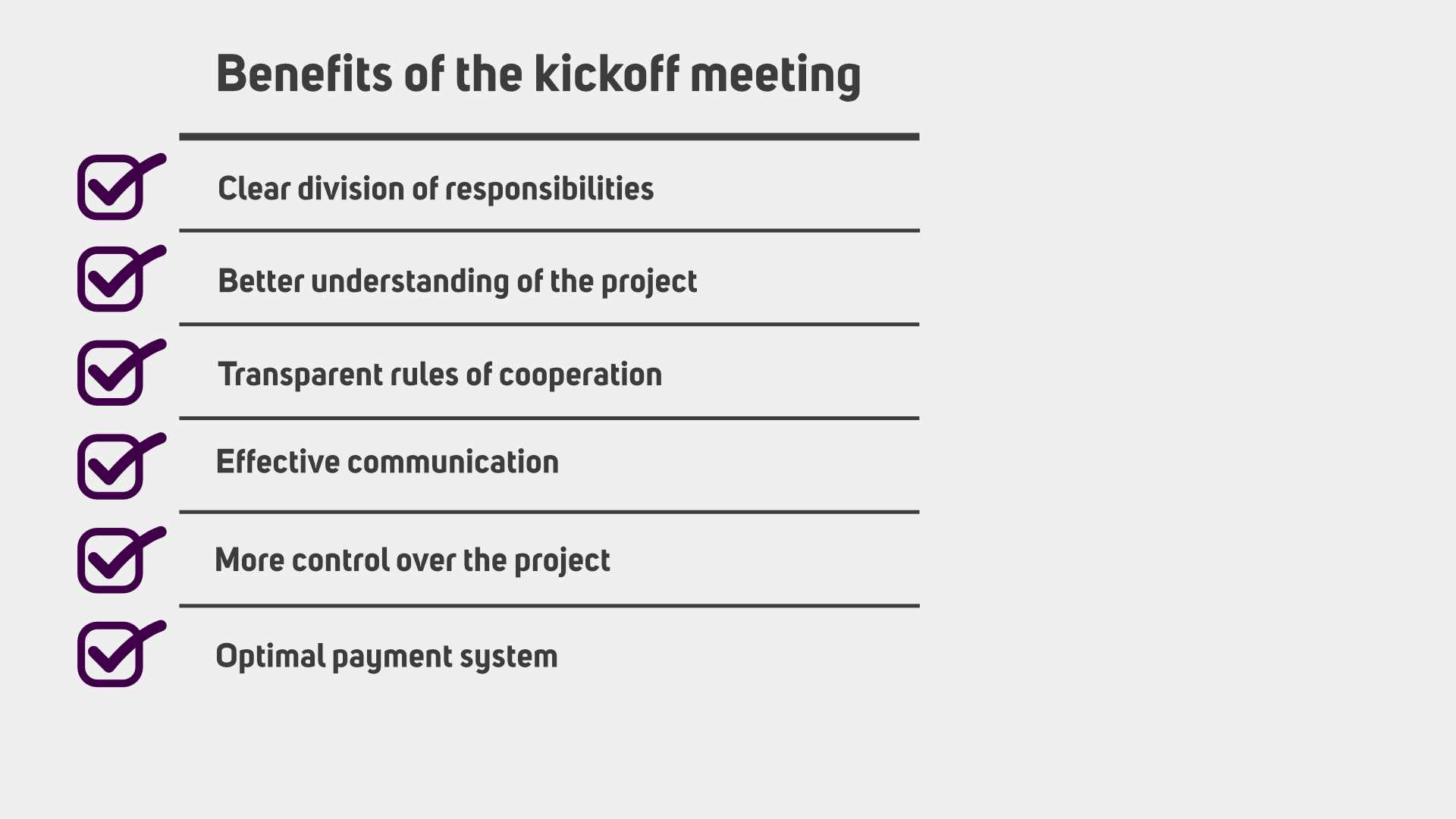The Project Kickoff Meeting: Step 1 in the App Development Process – All You Need to Know as a Product Owner

If you’re the product owner who has just received an invitation to a kickoff meeting – you probably have a lot of questions.
What will we do during the meeting? Why is it necessary? How should you get ready for it?
To help you prepare for this session, we’ve collected as many useful insights as possible. We hope this guide will make you feel more confident and allow you to achieve better results faster.
TL;DR
- A project kickoff meeting is a gathering where the team discusses organizational issues, goals, tools, responsibilities, and tasks to optimize cooperation and identify the main elements of the project. This meeting is essential before beginning the development process.
- The kickoff meeting typically takes place after clients meet with a sales manager and participate in a Product Design workshop. It is often the first meeting between the development team and the product owner.
- The participants in the kickoff meeting include the project manager or scrum master, software developers, QA testers, and optionally, an account manager, UX/UI designer, UX researcher, and other stakeholders from both the software company and client’s team.
- The main aspects of the app development process discussed in the kickoff meeting are trust, approach, roles and responsibilities, priorities, tools & organizational issues, and tasks.
- Building trust and creating a friendly working environment are crucial for successful cooperation. Thus, the team explains the agile methodology, ceremonies, and types of meetings that will take place during the app development process.
- Participants introduce their roles and responsibilities to ensure clear communication and assignment of tasks. Business goals, project vision and background are discussed to focus on essential aspects.
- Cooperation standards, including reports, meetings, and tools, are specified to ensure proper information flow and control over the process. The scope of the project or other relevant documents are introduced to show the planned tasks.
What is a project kickoff meeting?
The kickoff meeting is when the team gathers together to focus on the organizational issues, goals, tools, responsibilities, and tasks. We talk about the aspects that optimize the cooperation and identify the main elements of the project. Without the kickoff, we cannot begin the development process.
When does this meeting take place in a project timeline?
Before it comes to the kickoff, clients meet a sales manager. Then, depending on the scope, the entire team takes part in the Product Design workshop (it’s optional). Afterward, you receive the first draft of the estimation.
Next, it’s time for the project kickoff meeting. Quite often it’s the first meeting between the development team and the product owner (PO) with his or her team members.
Later on, you receive a more precise version of the estimation, and software developers start to work on the app.

Who takes part in the kickoff?
Software company team:
- Project Manager or Scrum Master – coordinator who supervises the development process
- Software developers – responsible for programming the app
- QA testers – specialists who check if the features and functionalities work according to plan
Optionally: Account Manager, UX/UI designer, UX researcher
Client’s team:
- Product Owner – a person who defines the scope of the sprint, sets the priorities, reviews the outcomes, and refines the backlog
Optionally: Business founder or product manager, UX/UI designer, UX researcher, QA testers, data analyst, backend specialists, other stakeholders

What do we focus on?
We talk about the 7 main aspects of the app development process. They determine our ways of operating and set a direction we will follow during the entire project lifecycle.
Trust
It might sound banal, but we really need to trust each other’s ideas if we are about to cooperate. From our experience, when everyone feels fully convinced about the project’s purpose, we achieve better results. So, the objective of the kickoff meeting is to build an atmosphere of enthusiasm and create a friendly working environment.
If a project manager is not fully convinced to the idea of the app, the entire product team will feel the same way. That’s the reason why we must understand the context of your product, so we could be genuinely as enthusiastic as you are about it. It always shows when the software is made by people who truly believe in its success.
Approach
Our team develops all the projects in agile methodology and now it’s the time when we explain to you what this means. You get to know what the ceremonies in the project lifecycle are. We also tell you what types of meetings we’re about to have over the course of the app development process (e.g., daily, sprint planning, retro), who takes part in them, and what engagement we expect from particular people.
Roles
It’s not enough that you know what to do. You need to be aware of what others have on their to-do lists, too. Project kickoff meeting is the time when everyone introduces their roles to the rest of the product team and describes their responsibilities. This way, when you have a question or want to assign a task, there’s don’t need to wonder who’s the best contact person.
Priorities
We have to make it clear what is your business goal and get familiar with the project background. Our team needs to know the idea that led you to build this product and what made you choose some particular solutions. Why? So, we can focus on the aspects that are truly essential for achieving the goal.
When planning a sprint with the product owner, we make sure what we want to achieve, why, and how. It’s the only way to ensure smooth cooperation and mutual understanding that lead to achieving business goals.
Tools and organizational issues
We specify the cooperation standards concerning the reports, meetings, tools, etc. All the project team members agree on the methods of work and the communication channels. It’s the only way we can ensure proper information flow that gives us more control over the process.
Tasks
The purpose of the kickoff meeting is also to introduce the scope of the project or another document that shows your plans concerning the product. We need you to tell us more about the MVP, too. We will talk about its key elements, so the team would know what kind of tasks await for them.
Useful term THE SCOPE OF THE PROJECT
The entire range of activities needed to complete the project. This includes the info about, for example, tasks, deadlines, estimated costs, and the resources used to build the product. It also describes the expected results of the cooperation between the software agency and the client.
The kickoff meeting agenda
Who works on the app? What is the project about? What is the product for? How are we supposed to cooperate? How much does it all cost?
Don’t worry, we will answer all these questions. Essentially, we cover 6 topics and save some time for the Q&A session.
Note We’ve decided to show you what this meeting usually looks like in our company. But its agenda is slightly different in every software agency. It depends on the type of project, too. Nevertheless, it’s almost always based on the agile approach, so the differences shouldn’t be significant.

The kick-off meeting step by step
1. Who works on a project? Team introduction
Both the software development team and the client’s team speak about their roles and responsibilities.
The outcome: We know who to talk to concerning certain issues.
2. What and who is the app for? Explaining the goal of the project
We talk about the business goal, the context the project is situated in, and the problems the product must address.
The outcome: We all understand the environment in which the product will perform, so it’s easier to choose the ultimate solutions.
3. What are we going to do? Presenting the project scope
The team members define what kind of tasks they must complete, what it takes to build the MVP, and what are initial plans for the future versions.
The outcome: We can imagine what you want to achieve, what the product should look like, and what solutions will help us build the versions of the app you need.
4. How are we going to work? Introducing the development methods
We explain to you our internal project management system.
The outcome: Everyone knows how the development process will be executed and what to expect at each stage.
5. How are we going to contact each other? Communication channels
Scrum master introduces our tools, describes what they are for, and how often we’re about to contact each other.
The outcome: With a tested toolset, we can easily keep everyone in the loop. This also speeds up the workflow because we can directly contact the right people.
6. How are we going to settle an account? Agreeing on the billing model
We choose how and when to make payments for the app development.
The outcome: The rules of billing are clear and satisfactory for both sides.
What tools and resources do you get?
Link to the project in Jira
If you want to keep an eye on the technical issues, we can add you to our space on Jira, dedicated to your app. You will find all the tasks there, so it’s easy to see at what stage the project is, what takes more time, what is in the testing phase, etc.

Link to the Slack workspace
This tool allows us to quickly exchange the info with the rest of the project team. You need to ask about the hour of the meeting? You want a link to the prototype? Just send us a message on Slack. Within the workspace, we create several channels, such as Tests, Bugs, General, etc., so there would be no doubt where to pose a question about a certain issue.
Contacts to everyone involved in a project
Although Slack is the fastest way of contacting each other, we always exchange our email addresses. It’s not only because it’s best to have an additional communication channel. We share some of the documents via Google Workspace or other tools that require e-mail to see the content.
Calendar with the project meetings
We create a calendar dedicated exclusively to your project. Everyone involved in development can find links to the online meetings there and check whether their presence is necessary. For example, for certain calls we are going to need only a Product Owner, but sometimes a backend team must also be invited. During the kickoff, we’ll let you know who needs to attend each type of meeting (sprint plannings, retrospectives, etc.).
Link to Figma or Adobe XD
If we are responsible for creating the UI design of the app, we give you access to the project in the tool we use for wireframing. You can check if the prototype works as you intended and verify if it looks the way you want it.
A get-ready list for the product owner
Before we meet, it’s best if you:
- Make sure everyone in your team knows you’re the decisive person – someone to go to when there are any questions concerning the app.
- When scheduling the date of the meeting, check if all your team members can take part in it – everybody involved in a project should be present.
- Prepare a list of questions you want the development team to answer.
- Allocate your team’s availability, so they could fully engage in a project.
What does our company prepare for the first meeting?
We’re not being idle when you do your part and get ready for the kickoff. At the same time, our project team:
- creates a dedicated Slack workspace, Jira project, etc.
- selects specialists for the project
- creates a schedule for the meetings (to be edited over the course of the project)
- works on the agenda and the presentation.
The benefits of the kickoff meeting
1. Clear division of responsibilities – when everybody knows what each team member is supposed to do at every stage of the project, we can quickly obtain the info we need. And there’s no risk that a problematic issue won’t be addressed.
2. A better understanding of the project – the team gets in-depth knowledge about the product and the problems it should solve. This way we make sure we’re all on the same page and have no doubts about what we want to achieve.
3. Transparent rules of cooperation – no one is taken aback when their scope of work changes. We’re aware of our responsibilities all the way to the release. We estimate how much time the client should save on certain phases of the process, so there won’t be any unpleasant surprises.
5. Effective communication – we know how often we are going to have our regular meetings and what are our communication channels. It makes the process of exchanging information more effective.
6. More control over the project – we define where we will store the shared documentation, the info about the scope, etc. It should be a place easily accessible to everyone who might need it.
7. Optimal payment system – depending on the billing model of your choice (time & materials or a fixed price), we talk about the financial issues, such as the settlement dates. In some cases, we talk about those aspects in a separate meeting.

What happens next?
When we know the project scope and the backlog is ready, we can move on to the next task. So, what’s first on our list?
We’re creating a repository on GitLab
Software developers need a safe place to store the code of the app. That’s the main reason why they create a repository on GitLab. This platform also allows them to track the changes they make to the code with a version control system.
Our team works out the product’s architecture
We test different configurations of the product’s architecture to find the one that seems the most functional.
We’re planning the scope of the first sprint
A project manager (or a scrum master) together with a product owner decide what’s the main goal of the first sprint and what tasks it should involve. Cooperation with the Product Owner becomes crucial at this point. Such a person must be fully responsive because at the beginning, many new questions arise. It’s important to find the answers as quickly as possible.
After the kickoff, we can finally proceed to the part everyone was waiting for – the actual development of the app. Don’t hesitate to contact us, if you have any doubts concerning the meeting or the whole process. We’ll help you get ready for your next successful project.
Read more:
- What happens before the kickoff? All you need to know about the Product Discovery
- Design Sprint or Brainstorming – How to Solve Problems in Mobile App Projects?
- Product Owner vs Product Manager: Learn the Differences Before the Project Begins
- Time and Materials vs Fixed Price – Overview of Pros and Cons that will Help You Choose the Right Billing Model






